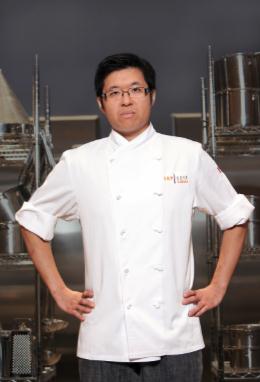Curtis Luk, former sous chef of Courtyard Restaurant in the Byward Market, was one of two Ottawa chefs who starred in the second season of Top Chef Canada. He got chopped for a deconstructed tuna casserole in Episode 7.
Now, he’s headed to Vancouver to be the chef de cuisine at a new farm-to-table restaurant being opened by his fellow contestant, Trevor Bird. Xtra writer Laura Zahody recently chatted with him about Top Chef and more.
Xtra: Is there a common thread between the restaurants you’ve worked at?
Curtis Luk: They’re all different, which is what I prefer. Having a broad variety of experiences is very important, so that’s what I push myself to do when I look for new jobs and opportunities.
Was reality TV something you have always wanted to experience?
Honestly, it was more about the competition aspect than the TV. But it was definitely interesting to learn about the TV industry.
What have you learned about TV?
There’s a lot of waiting – just waiting for things to happen. Then it happens and it’s over and there’s more waiting.
Tell me about auditioning. What did you do to get on the show?
The audition tape [see below] I sent in was of me making baked Alaska with liquid nitrogen. I feel that that really represents who I am, in terms of me using new techniques to make something classic. And it’s something I enjoy – pastry. I haven’t seen liquid nitrogen used on any other audition tapes, at least not the Canadian ones, so I think that made me stand out.
What else makes you stand out?
I went to university before cooking. I studied computer science and mathematics at the University of Waterloo. A lot of cooks are very intuitive in their cooking. Me, I’ve learned to be analytical and I really enjoy numbers. That gives me a huge advantage in terms of pastry and using new techniques. These things require precision and numbers. I have a good understanding of and memory for numbers, so I get why things work and why things don’t.
What are your secret weapons?
Pastries. I think a lot of chefs need recipes in front of them for pastries. It’s harder to intuit baking unless you’ve been doing it for 30 years. You really have to know and understand the ratios and math behind it.
That really came through with the macaroons you made in Episode 3.
They were certainly a risk. I’m a competitive person, and with the macaroons I wanted to show what I could do. I hope that it said, “Watch out – I can do this!”
What do you eat at home?
Oh my gosh, there’s nothing. There’s almost nothing – just Asian condiments and beer. The most I’ve had at home is cheese and bread and jam.
What are you putting the Asian condiments on?
They’re for work stuff. I just brought them to work and took them back. I’m using them in other people’s kitchens, but not my own.
You’re heading to Vancouver to work at a new restaurant, Fable, with another Top Chef competitor, Trevor Bird. Tell me about it.
The concept is farm to table. It’s knowing where your food comes from and presenting it in a way that’s not overly complicated or, perhaps, pretentious.
Is this a big switch for you?
It is. But I’ve convinced Trevor to get liquid nitrogen. I like to sneak in some things I’ve always worked with in the past. I don’t think it’s either/or. It’s not either you present fresh and sustainable food or you use new techniques. It’s always both. New ingredients and techniques are just another way of highlighting the food.

 Why you can trust Xtra
Why you can trust Xtra


